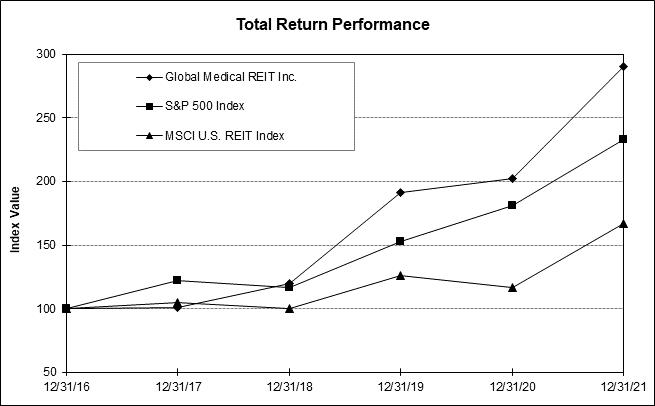in our rental income, which could increase our expenses and materially adversely affect our business, financial condition, results of operations, our ability to make distributions to our stockholders and the trading price of our common and preferred stock.
The bankruptcy of any of our tenants could bar our efforts to collect pre-bankruptcy debts from the tenant or evict the tenant and take back control of the property.
As of December 31, 2021, we have had one tenant file for bankruptcy. Any bankruptcy filings by or relating to one of our tenants could bar all efforts by us to collect pre-bankruptcy debts from that tenant or evict the tenant and take back control of the property, unless we receive an order permitting us to do so from a bankruptcy court, which we may be unable to obtain. A tenant bankruptcy could also delay our efforts to collect past due balances under the relevant leases and could ultimately preclude full collection of these sums. If a tenant rejects the lease while in bankruptcy, we would have only a general unsecured claim for pre-petition damages. Any unsecured claim that we hold may be paid only to the extent that funds are available and only in the same percentage as is paid to all other holders of unsecured claims. It is possible that we may recover substantially less than the full value of any unsecured claims that we hold, or nothing at all, which may have a material adverse effect on our business, financial condition, results of operations, our ability to make distributions to our stockholders and the trading price of our common stock and preferred stock. Furthermore, dealing with a tenant bankruptcy or other default may divert management’s attention and cause us to incur substantial legal and other costs.
The physical effects of climate change could have a material adverse effect on our properties.
The physical effects of climate change could have a material adverse effect on our facilities, operations, and business. To the extent climate change causes changes in weather patterns, markets where our properties are located could experience increases in storm intensity, rising sea-levels, and changes in precipitation, temperature, and air quality. Over time, these conditions could result in physical damage to, or declining demand for, our properties or our inability to operate the facilities at all. Climate change may also indirectly affect our business by increasing the cost of (or making unavailable) property insurance on terms we find acceptable, increasing the cost of energy and increasing the risk of flood at our properties. Should the impact of climate change be severe or occur for lengthy periods of time, our business, financial condition, results of operations, or our ability to make distributions to our stockholders and the trading price of our common and preferred stock could be materially adversely impacted.
Adverse economic or other conditions in our geographic markets could negatively affect our tenants’ ability to pay rent to us.
Adverse economic or other conditions in our geographic markets, including periods of economic slowdown or recession, industry slowdowns, periods of deflation, relocation of businesses, changing demographics, earthquakes and other natural disasters, fires, terrorist acts, public health crisis, pandemics and epidemics, such as the COVID-19 pandemic, and civil disturbances or acts of war and other man-made disasters which may result in uninsured or underinsured losses, and changes in tax, real estate, zoning and other laws and regulations, may negatively affect our tenants’ businesses and ability to pay rents to us and, therefore, could have a material adverse effect on our business, financial condition and results of operations, our ability to make distributions to our stockholders and the trading price of our common and preferred stock.
Most of our healthcare facilities are occupied by a single tenant, and we may have difficulty finding suitable replacement tenants in the event of a tenant default or non-renewal of our leases, especially for our healthcare facilities located in smaller markets.
As of December 31, 2021, leases representing 1.5%, 6.2% and 16.2% of our portfolio annualized base rent expire in 2022, 2023 and 2024, respectively. Most of our healthcare facilities are occupied by a single tenant. Following expiration of a lease term or if we exercise our right to replace a tenant in default, rental payments on the related healthcare facilities could decline or cease altogether while we reposition such healthcare facility with a suitable replacement tenant. We also might not be successful in identifying suitable replacement tenants or entering into triple-net leases with new tenants on a timely basis, on favorable terms, or at all. Additionally, we may be required to fund certain expenses and obligations (e.g., real estate taxes, debt costs and maintenance expenses) to preserve the value of, and avoid the imposition of liens on, our healthcare facilities while they are being repositioned. Our ability to reposition our healthcare facilities with a suitable tenant could be significantly delayed or limited by state licensing, receivership, CON or other laws, as well as by the Medicare and Medicaid change-of-ownership rules. We could also incur substantial additional expenses in connection with any licensing, receivership or change-of-ownership proceedings. In addition, our ability to locate suitable replacement tenants could be impaired by the specialized healthcare uses or contractual restrictions on use of the healthcare facilities, and we may be required to spend substantial amounts to adapt the healthcare facilities to other uses. Any such delays, limitations and expenses could adversely impact our ability to collect rent, obtain possession of leased healthcare facilities or otherwise exercise remedies for tenant default,
